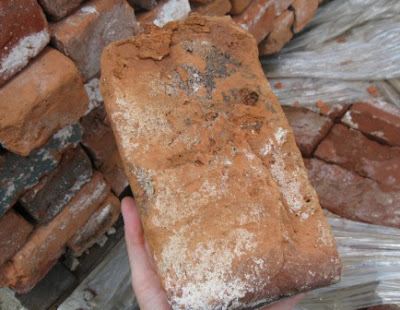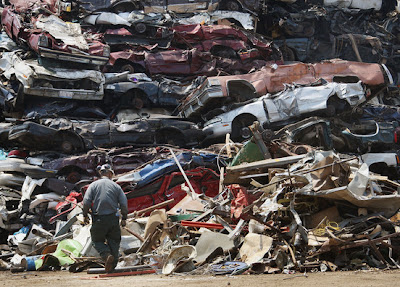What is Recycling ?
 |
| 3R (Reuse, Reduce, and Recycle ) |
Recycling is the process to make a scrap materials into new materials with the aim of preventing the waste that can actually be something useful, reducing the use of new raw materials, reduce energy use, reduce pollution, land degradation, and greenhouse gas emissions when compared with new manufacturing processes. Recycling is one of the solid waste management strategy which consists of the activities of sorting, collecting, processing, distribution and manufacture of products / materials used, and the main component in modern waste management and the third in the hierarchy of waste 3R (Reuse, Reduce, and Recycle).
The material consists of recycled waste glass, plastic, paper, metals, textiles, and electronic goods. Although similar, the composting process that generally uses waste biomass which can be degraded by nature, are not categorized as a recycling process. Recycling is more focused on waste that can not be degraded by natural naturally by reducing land degradation. Broadly speaking, recycling is the process of garbage collection, sorting, cleaning, and processing of new materials for the production process.
In a limited understanding, the recycling process must produce goods that are similar to the original items with the same material, for example waste paper should be a paper with the same quality, or polystyrene foam polystyrene used should be of similar quality. Often, this is difficult because it is more expensive than the process of making the new material. So, recycling is the reuse of materials into different products. Another form of recycling is the extraction of valuable materials from waste, such as gold from computer processors, lead from batteries, or extraction of materials that are harmful to the environment, such as mercury.
Recycling is something extraordinary that can be obtained from the trash. Aluminum can recycling process saves 95% energy and reduce air pollution by 95% when compared with the extraction of aluminum from quarry to the process at the factory. Substantial savings in energy is also obtained by recycling paper, metal, glass, and plastics.
Materials that can be recycled and the process are:
Building materials
Used building materials that have been collected are destroyed with a shredder, sometimes in conjunction with asphalt, bricks, soil, and rocks. The results can be used a rougher coating similar to asphalt road and a more refined results can be used to create new building materials like brick.
In a limited understanding, the recycling process must produce goods that are similar to the original items with the same material, for example waste paper should be a paper with the same quality, or polystyrene foam polystyrene used should be of similar quality. Often, this is difficult because it is more expensive than the process of making the new material. So, recycling is the reuse of materials into different products. Another form of recycling is the extraction of valuable materials from waste, such as gold from computer processors, lead from batteries, or extraction of materials that are harmful to the environment, such as mercury.
Recycling is something extraordinary that can be obtained from the trash. Aluminum can recycling process saves 95% energy and reduce air pollution by 95% when compared with the extraction of aluminum from quarry to the process at the factory. Substantial savings in energy is also obtained by recycling paper, metal, glass, and plastics.
Materials that can be recycled and the process are:
Building materials
Used building materials that have been collected are destroyed with a shredder, sometimes in conjunction with asphalt, bricks, soil, and rocks. The results can be used a rougher coating similar to asphalt road and a more refined results can be used to create new building materials like brick.
 |
| Building materials |
 |
| Recycling Building materials |
Battery
The amount of variation and the size of the battery makes the process of recycling this material is relatively difficult. They must be sorted first, and each type has a special interest in the processing. For example, long battery types still contain mercury and cadmium, should be treated more seriously in order to prevent damage to the environment and human health.
The car battery is generally much easier and cheaper to recycle.
The amount of variation and the size of the battery makes the process of recycling this material is relatively difficult. They must be sorted first, and each type has a special interest in the processing. For example, long battery types still contain mercury and cadmium, should be treated more seriously in order to prevent damage to the environment and human health.
The car battery is generally much easier and cheaper to recycle.
 |
Printed Electronics
Popular electronic goods such as computers and mobile phones are generally not recycled because it is not clear calculation of economic benefits. Materials that can be recycled from electronic goods such as metal is contained in the electronic goods (gold, iron, steel, silicon, etc.) or the parts are still usable (microchips, processors, cables, resistors, plastic, etc.). But the main purpose of the recycling process, namely the preservation of the environment, it can clearly be a goal in the implementation process of recycling this material despite its economic benefits are still unclear.
Popular electronic goods such as computers and mobile phones are generally not recycled because it is not clear calculation of economic benefits. Materials that can be recycled from electronic goods such as metal is contained in the electronic goods (gold, iron, steel, silicon, etc.) or the parts are still usable (microchips, processors, cables, resistors, plastic, etc.). But the main purpose of the recycling process, namely the preservation of the environment, it can clearly be a goal in the implementation process of recycling this material despite its economic benefits are still unclear.
 |
| Recycling Printed Electronics |
Metal
Iron and steel are the metals most widely recycled in the world. Including one of the easiest because they can be separated from other debris with magnets. Recycling includes the process of metal in general; smelting and printing again. The results did not reduce the quality of the metal.
Another example is aluminum, which is the most efficient recycled materials in the world. But in general, all types of metal can be recycled without reducing the quality of the metal, making the metal as a material that can be recycled indefinitely.
 |
| Recycling Metal waste |
 |
| Recycling Metal waste |
Other Materials
Glass
Glass can also be recycled. Obtained from glass bottles and other materials dair cleaned of contaminants, and then melted together with a new glass material. Can also be used as building materials and roads. There are already Glassphalt, ie coating material way by using 30% recycled glass material.
Glass can also be recycled. Obtained from glass bottles and other materials dair cleaned of contaminants, and then melted together with a new glass material. Can also be used as building materials and roads. There are already Glassphalt, ie coating material way by using 30% recycled glass material.
Paper
Paper can also be recycled by mixing the waste paper that has been used as paper pulp with new material. But the paper will always experience a loss of quality if it continues to be recycled. This makes the paper should be recycled by mixing with new material, or recycle it into a lower-quality materials.
Plastics
Plastics can be recycled just as metal recycling. Only, there are different types of plastics in the world. Currently in a variety of plastic products code found on the type of plastic that make up the material which makes it easier to recycle. A code on the packaging that 3R triangular with code numbers in the middle is an example. A certain number indicates a particular type of plastic, and sometimes followed by an abbreviation, for example LDPE Low Density Poly Etilene, PS for Polystyrene, etc., thus simplifying the process of recycling.
A common type of plastic code circulating among others:
Plastics can be recycled just as metal recycling. Only, there are different types of plastics in the world. Currently in a variety of plastic products code found on the type of plastic that make up the material which makes it easier to recycle. A code on the packaging that 3R triangular with code numbers in the middle is an example. A certain number indicates a particular type of plastic, and sometimes followed by an abbreviation, for example LDPE Low Density Poly Etilene, PS for Polystyrene, etc., thus simplifying the process of recycling.
A common type of plastic code circulating among others:
- PET (Polyethylene terephthalate). Generally located on the consumption of bottled beverages or other liquid materials.
- HDPE (High Density Polyethylene, high density polyethylene) usually found on detergent bottles.
- PVC (polyvinyl chloride) are commonly found in plumbing, rnitur, and so on.
- LDPE (Low Density Polyethylene, low density polyethylene) are commonly found on food packaging.
- PP (polypropylene) is generally found on bottle caps, straws, and some types of toys.
- PS (polystyrene) commonly found in food boxes, packing boxes of meat, cups, and other kitchen appliances.
Recycling Crafts
EmoticonEmoticon